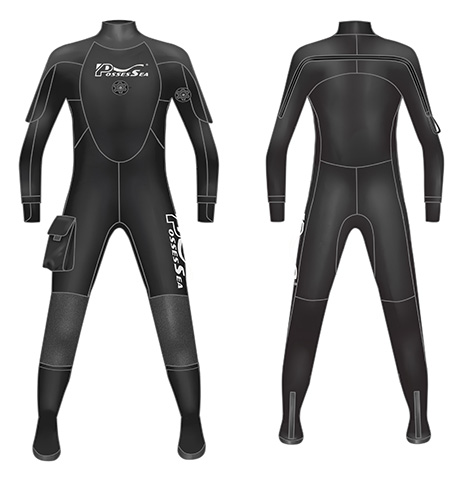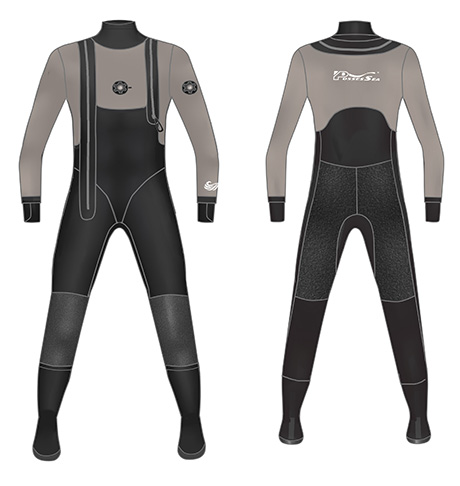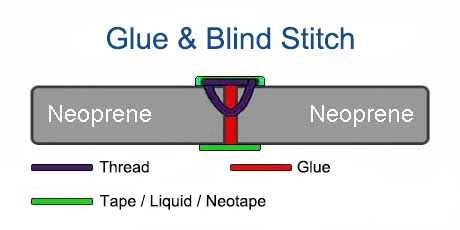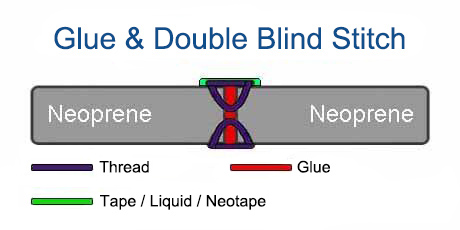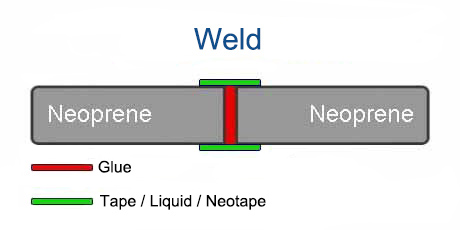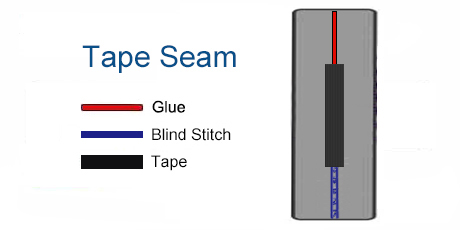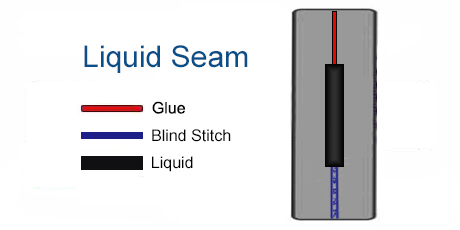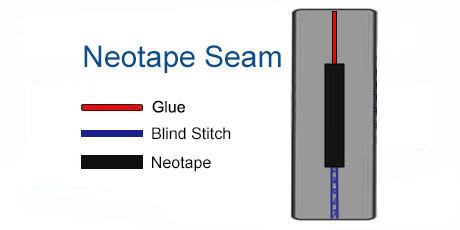Possess Sea Industrial Co., Ltd. - Drysuits Division
Professional Drysuit & Waders Manufacturer, Supplier and Exporter in China
Professional Drysuit & Waders Manufacturer, Supplier and Exporter in China
Contact: Ms.Maggie, Mobile / WhatsApp: +86 138 168 15888, E-mail: maggie@wetsuit.asia
Neoprene Drysuit - Manufacturer and Supplier
Neoprene is a traditional drysuit manufacturing material. Special models of high-density neoprene (Japan-YAMAMOTO #88 / Taiwan-Nam Liong DS) are usually used. Sometimes due to cost considerations, standard neoprene (Taiwan-Nam Liong F04 / W7 / W8) is also used. The standard neoprene has low density, large buoyancy, and poor compression resistance. The drysuit made is slightly inferior in performance, but lower in cost.
The neoprene drysuit is soft and flexible, has good thermal performance, and is durable. The disadvantage is that it is bulky, has a certain buoyancy, is greatly affected by compression (Especially when using standard neoprene), and has a longer drying time. Neoprene drysuits are mainly used in cold waters and are not suitable for warm environments.
Neoprene drysuits optional back zipper or front diagonal zipper, equipped with inflation valve and exhaust valve, heavy vulcanized rubber boots, neck and wrists use seals to prevent water ingress (Commonly available are smooth skin seals and latex seals. The smooth skin seals have a longer service life, but less elasticity. The latex seals are soft and can be adjusted for cutting, but need to be replaced regularly.).
Neoprene Drysuit - DN01
Material: CR neoprene (Taiwan-Nam Liong F04 / W7 / W8), double laminated nylon fabric.
Thickness: 4mm (Provide other thickness).
Process: "GBS", non-penetration stitching method after bonded with glue. "Weld", all bonded with glue and stitch-free. The seam line can be reinforced with "Tape" / "Liquid" / "Neotape".
Neck / Wrists: Smooth skin seals (self-produce) / latex seals (UK).
Back Zip: YKK® PROSEAL® (BDM - CR44).
Inflation / Exhaust Valve: SI-TECH®.
Shoulders / Elbows / Knees: KEVLAR®.
Feet: Heavy vulcanized rubber boots.
Neoprene Drysuit - DN02
Material: High density CR neoprene (Japan-YAMAMOTO #88 / Taiwan-Nam Liong DS), outer layer laminated small diamond fabric / nylon fabric, inner layer laminated thermal fabric / nylon fabric.
Thickness: 4mm (Provide other thickness).
Process: "GBS", non-penetration stitching method after bonded with glue. "Weld", all bonded with glue and stitch-free. The seam line can be reinforced with "Tape" / "Liquid" / "Neotape".
Neck / Wrists: Smooth skin seals (self-produce) / latex seals (UK).
Loop Zip: YKK® PROSEAL® (BDM - CR44).
Inflation / Exhaust Valve: SI-TECH®.
Shoulders / Elbows / Knees: DuPont™ KEVLAR®.
Feet: Heavy vulcanized rubber boots.
Seam Construction
GBS: After the two pieces neoprene fabric are bonded with "Glue", the seam is then sewed with "Blind Stitch" process.
Weld: After the two pieces neoprene fabric are bonded with "Glue", the two sides of the seam is then reinforced with "Tape" / "Liquid" / "Neotape".
Seam Reinforcement
Tape Seam: Using fabric as a substrate, bonded by hot melt adhesive film, thin, the cost is relatively cheap.
Liquid Seam: Using liquid rubber as a substrate, forming a protective tape after curing, has smooth surface, and waterproof performance is the best.
Neotape Seam: Using CR neoprene as a substrate, bonded by glue, has better elasticity, firmness and waterproof performance, but the cost is relatively higher.
High Density Neoprene for Drysuit:
| Type | Elongation Rate (%) | Density (g/cm3) | Hardness (Type C) |
| DS | 300 | 0.30 | 15-20 |
| #88 | 312 | 0.36 | 15-20 |
Remark: This is a high density neoprene for drysuits. It is a special high-strength material made by special compression directly in the sponge production process to increase the density of neoprene. Low buoyancy, high compression resistance, but expensive, suitable for professional and extreme fields.
Standard Neoprene for Drysuit:
| Type | Elongation Rate (%) | Density (g/cm3) | Hardness (Type C) |
| W8 | 450 | 0.18 | 3-5 |
| W7 | 500 | 0.18 | 5-7 |
| F04 | 450 | 0.20 | 9-11 |
Remark: This is a standard neoprene. It is mainly used to make wetsuits, the price is relatively cheap. The drysuits made of this material have slightly lower performance and are mainly used in general fields.
Drysuit Type:
| Type | Neoprene Drysuit | Butyl Drysuit | Breathable Drysuit |
| Material | Neoprene Fabric | Butyl Fabric | Breathable Fabric |
| Process | Glue & Blind Stitch + Glue Tape | Flatlock Stitch + Glue Tape | Flatlock Stitch + Hot Tape |
| Firmness | Good | Good | Ordinary |
| Easy to Carry | Not Good | Ordinary | Good |
| Thermal Insulation | Good | Little | Little |
| Valve | Inflation Valve, Exhaust Valve | Inflation Valve, Exhaust Valve | No or Dump Valve |
| Applications | Diving | Diving | Water Sports, Rescue |

